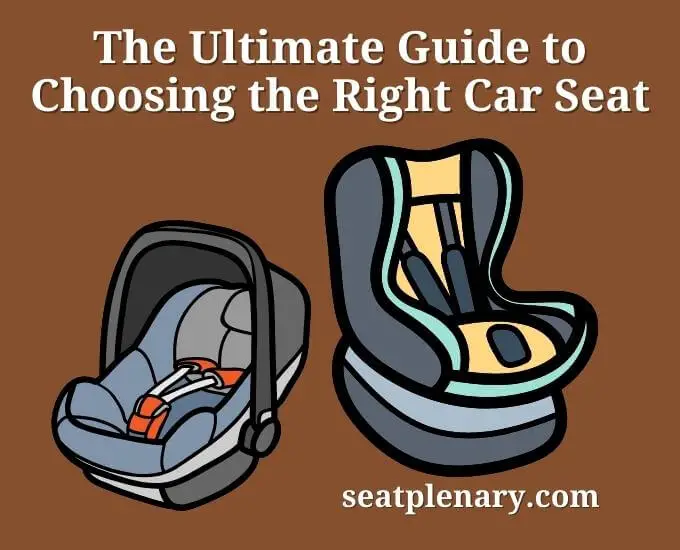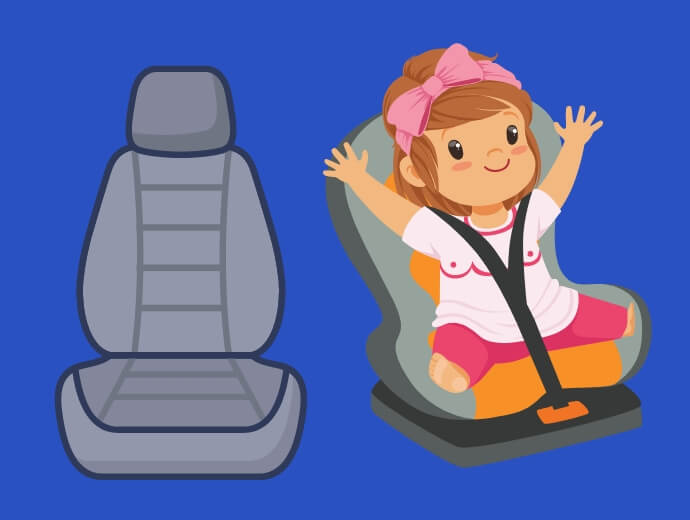As a parent, keeping your child safe is a top priority. Unfortunately, car accidents are a leading cause of injury and death for children in the United States. However, the use of a properly installed car seat can reduce the risk of injury or death by up to 71%. Therefore, choosing the right car seat for your child is not just important, but it could be life-saving.
It’s easy to feel overwhelmed with the many options available for car seats, and the varying features and designs of each can make the selection process seem daunting. That’s why we’ve put together this ultimate guide to help you make an informed decision when selecting a car seat for your child.

The different types of car seats, safety features, installation methods, comfort and convenience, brand and price, and other factors to consider, you can choose a car seat that not only fits your budget but also keeps your child safe and comfortable on every car ride. So, let’s dive into the details to help you make an informed decision when choosing the right car seat for your child.
Types of Car Seats
When it comes to selecting the right car seat for your child, there are different types to consider. Each type is designed to meet the specific safety and developmental needs of children of different ages and sizes. Here are the four main types of car seats:
Infant Car Seats
Infant car seats are designed for newborns and infants up to 2 years old or until they reach the maximum weight or height limit allowed by the manufacturer. These car seats are rear-facing, which is the safest position for young children and provide a snug fit to support a baby’s delicate head, neck, and spine. Infant car seats often come with a detachable base that can stay in the car, making it easy to remove and install the car seat.
Convertible Car Seats
Convertible car seats can be used both rear-facing for infants and forward-facing for toddlers and young children. They are designed to accommodate a child’s growth and can be used from birth up to around 4 years old or until the child reaches the maximum weight or height limit allowed by the manufacturer. Convertible car seats can be a cost-effective option since they can be used for a longer period compared to infant car seats.
Booster Car Seats
Booster car seats are designed for older children who have outgrown their forward-facing car seats. They are used in the forward-facing position and raise a child’s seating position, allowing the seat belt to fit properly over their body. Booster seats can be used from around 4 years old to 8-12 years old, depending on the child’s height and weight.
Combination Car Seats
When selecting a car seat, it’s essential to choose one that matches your child’s age, weight, and height. It’s also important to follow the manufacturer’s guidelines and instructions for proper installation and usage of the car seat. Selecting the appropriate type of car seat for your child, you can provide them with the safest and most comfortable car ride possible.
Combination car seats combine a forward-facing car seat with a booster seat. They are designed for toddlers and young children, and they can be used in both the forward-facing position and as a booster seat. Combination car seats can be used from around 2 years old to around 8-12 years old, depending on the child’s height and weight.
Comfort and Convenience Features
When choosing a car seat for your child, it’s essential to consider their comfort and convenience. After all, long car rides can be uncomfortable, especially for children. Here are some comfort and convenience features to look for when selecting a car seat:

Padding and Recline Options
A car seat with adequate padding can provide extra comfort for your child, especially during long car rides. Some car seats have multiple recline options that allow you to adjust the angle of the seat for your child’s comfort, whether they’re sitting up or sleeping.
Harness Adjustments
A car seat with easily adjustable harness straps can make it easier to get your child in and out of the seat. Look for a car seat with a no-rethread harness, which allows you to adjust the harness height without having to rethread the straps manually.
Headrest and Cup Holders
Some car seats come with adjustable headrests that can be moved up or down to accommodate your child’s height as they grow. Cup holders can be a convenient feature to have for your child’s drink or snacks, especially during long car rides.
Removable Covers
Car seats can get dirty quickly, so having a removable and washable cover can make your life easier. Look for a car seat with a cover that is easy to remove and machine washable.
LATCH System
The LATCH system, which stands for Lower Anchors and Tethers for Children, is a set of standardized anchors in a vehicle that can be used to attach a car seat to the car without using the seat belt. Look for a car seat with an easy-to-use LATCH system, as this can make installation and removal much more convenient.
When selecting a car seat, it’s important to prioritize safety over comfort and convenience features.
Installation
Installing a car seat can be a daunting task for many parents, but proper installation is critical for ensuring your child’s safety. In fact, according to the National Highway Traffic Safety Administration (NHTSA), as many as 59% of car seats are not installed correctly. Here are some things to consider when installing a car seat:
Read the Manual
Before installing your car seat, it’s essential to read the manufacturer’s manual carefully. The manual will provide step-by-step instructions for proper installation and usage of the car seat. Pay close attention to weight and height limits, and follow the instructions for adjusting the harness and installing the car seat in the vehicle.
Choose the Right Spot
The safest place for a car seat is in the back seat of the car. Additionally, be sure to check your vehicle owner’s manual for specific guidelines on where to install a car seat. Some vehicles have LATCH anchors located in the middle seat, while others have them on the side seats.
Use the Right Method
Car seats can be installed using either the LATCH system or the seat belt. Make sure you are using the proper installation method as outlined in the manufacturer’s instructions. Remember that the LATCH system has a weight limit, and you may need to switch to using the seat belt for installation once your child reaches that limit.
Check for a Tight Fit
After installing the car seat, check for a tight fit. A properly installed car seat should not move more than one inch in any direction when tested at the base of the seat. Check the harness straps to make sure they are tight and snug on your child. If the harness is too loose, it can compromise the effectiveness of the car seat in the event of an accident.
Seek Professional Help
If you are still unsure about the installation process, seek help from a certified Child Passenger Safety Technician (CPST). CPSTs are trained professionals who can help you with the installation process and ensure that your car seat is installed correctly.
Remember, proper installation is critical for your child’s safety, and taking the time to ensure your car seat is installed correctly can provide peace of mind while driving.
Safety Features
When it comes to choosing a car seat for your child, safety should be the top priority. Car seats are designed to protect children in the event of a crash, but not all car seats are created equal. Here are some safety features to consider when choosing a car seat:
Five-Point Harness
A five-point harness is one of the most important safety features to look for in a car seat. The harness includes two straps that go over your child’s shoulders, two that go around their hips, and one that goes between their legs. This design helps distribute the force of a crash more evenly and helps keep your child securely in the seat.
Side-Impact Protection
Side-impact crashes can be particularly dangerous for children, as they can cause severe head and neck injuries. Look for a car seat with side-impact protection, which can include energy-absorbing foam or special wings that help protect your child’s head and neck in the event of a crash.
Adjustable Headrest and Recline Options
Adjustable headrests and recline options can be important safety features, particularly for younger children. A properly adjusted headrest can help protect your child’s head and neck in the event of a crash, while adjustable recline options can help ensure a proper fit for your child’s size and weight.
Tether and Lower Anchor System
The tether and lower anchor system, also known as LATCH, is a standardized system designed to make installing car seats easier and more secure. Look for a car seat with an easy-to-use LATCH system that allows you to anchor the seat to your car without using the seat belt.
Weight and Height Limits
Be sure to choose a car seat with weight and height limits appropriate for your child’s size and age. Using a car seat that is too small or too large can compromise its effectiveness in the event of a crash.
Crash Test Ratings
Lastly, be sure to research the crash test ratings for any car seat you are considering. Look for car seats that have been tested and approved by the National Highway Traffic Safety Administration (NHTSA) or the Insurance Institute for Highway Safety (IIHS). These ratings can provide valuable information about a car seat’s safety and effectiveness in real-world crash scenarios.
Remember, safety should be the top priority when choosing a car seat for your child. By considering these safety features and doing your research, you can help ensure that your child is protected in the event of a crash.
Conclusion
Choosing the right car seat is a critical decision for parents to make. It’s important to consider a range of factors, including the type of car seat, comfort and convenience features, installation, and safety features. By taking the time to carefully research and choose a car seat that meets your child’s needs, you can help ensure that they stay safe and secure while riding in the car.
Remember, car seats are designed to protect your child in the event of a crash, but they can only do so if they are installed.
FAQs
How Do I Determine the Best Type of Car Seat for My Child’s Age and Size?
The best type of car seat for your child’s age and size will depend on factors such as height, weight, and age. It’s important to refer to the car seat manufacturer’s guidelines and your state’s laws to determine which car seat is appropriate for your child.
Are There Any Special Car Seats for Preemies or Newborns?
Yes, there are special car seats for preemies or newborns. These may include infant car seats with lower weight and height limits, or specially designed car beds for premature babies.
Are Car Seats Regularly Tested to Ensure Safety and Quality?
Yes, car seats are regularly tested to ensure safety and quality. They are subject to rigorous testing and certification standards, including crash testing and evaluations of their materials and construction. It’s important to purchase car seats from reputable manufacturers and to follow their installation and usage guidelines.
